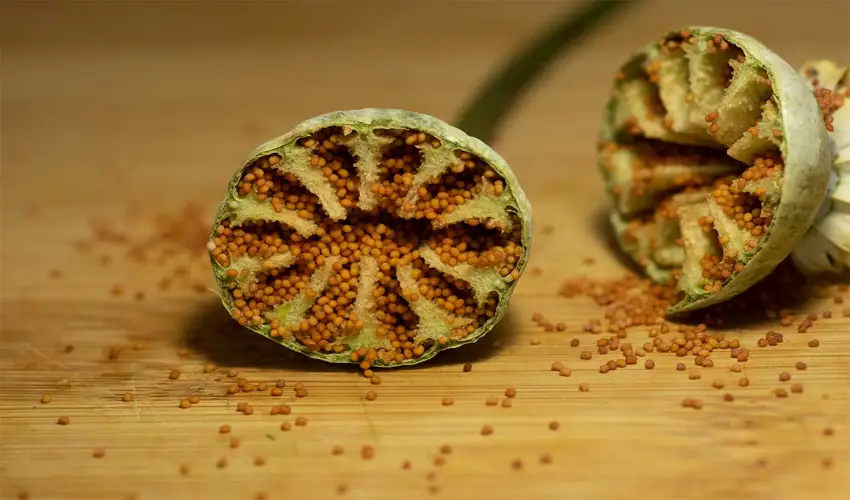Poppy pods are fascinating botanical structures, known for their unique characteristics and the important role they play in the life cycle of the poppy plant. However, when compared to other seed pods in nature, poppy pods stand out for several reasons. These differences go beyond appearance, touching upon their structure, uses, and the plants they originate from. Let’s explore how poppy pods differ from other seed pods.
- The Structure of Poppy Pods
The poppy pod, also known as a seed capsule, is typically round or oval in shape and contains a single chamber filled with numerous seeds. Poppy pods are often considered distinctive because of their wide, flat surface and the small holes that perforate the top of the pod. These holes, called “pores,” allow for the release of seeds when the pod matures. In contrast, many other seed pods, such as those of beans or peas, typically have smooth surfaces with no such openings. Other plants like sunflowers or dandelions rely on different mechanisms to disperse their seeds, such as wind or animals, rather than the mechanical release method seen in poppy pods.
- The Seed Distribution Process
The way poppy pods release their seeds is another characteristic that differentiates them from many other seed pods. As the pod matures and dries, it becomes brittle. When the pod is disturbed, it will often explode, sending the small seeds flying out into the environment. This dramatic dispersion method is in contrast to the more passive distribution methods seen in many plants. For example, sunflower seeds are typically released by the breaking down of the flower head but do not “explode” in the same dramatic fashion as papaver somniferum pods.
Many plants, such as the cotton plant, use a slower, more deliberate method of seed dispersal. These pods do not explode but rather open gradually, releasing seeds over time or through the action of environmental factors like wind or animals. This slower method contrasts with the quick burst of seed release from poppy pods.
- Medicinal and Commercial Value of Poppy Pods
One of the most significant differences between poppy pods and other seed pods is their historical and contemporary value. While most seed pods serve primarily to protect and disperse seeds, poppy pods have been used for various medicinal purposes. Poppy plants, particularly the opium poppy (Papaver somniferum), are famous for their role in producing opium, from which morphine, codeine, and other alkaloids are derived.
These substances have been used for pain relief and medicinal purposes for centuries. The presence of these compounds makes poppy pods a unique part of the plant kingdom. This is a stark contrast to most other seed pods, which do not contain such potent substances and are often used only for their seeds or as food sources.
In contrast, seed pods of plants like sunflower or pumpkin are primarily valued for their seeds, which are harvested for human consumption, but these seeds do not have the same potent medicinal properties as poppy seeds. The medicinal role of poppy pods has had a profound impact on medicine, particularly in the development of pain management medications.
- Differences in Appearance and Size
Poppy pods tend to be smaller and more compact than many other seed pods. For example, the poppy pod is typically 1-2 inches tall, and the seeds are very tiny, making them difficult to handle without precision. Other seed pods, like those of the pumpkin or acorn, are much larger and more robust, often with thicker, tougher outer shells designed to protect the seeds inside.
Poppy pods also have a distinctive appearance, often with a slight smoothness and a pale, greenish color that eventually turns brown as they dry out. Some poppy varieties even feature ornamental pods used in decorative floral arrangements due to their unique shape and texture. This aesthetic appeal sets them apart from many other seed pods that lack this decorative quality.
- Cultivation and Agricultural Differences
Another significant difference is how poppy plants are cultivated. The cultivation of poppies, especially for medicinal or ornamental purposes, requires specific environmental conditions. These plants thrive in well-drained, fertile soil and need plenty of sunlight to produce healthy pods. While many other plants, like sunflowers or beans, are relatively easy to grow in various climates, poppy plants are typically more sensitive to growing conditions, especially when cultivated for opium production, which is regulated in many parts of the world.
In contrast, plants like beans and peas are widely cultivated in a range of climates and regions due to their robust nature. They don’t require the same level of specialized care, which makes poppy pods stand out as a more demanding crop.
- Legal and Ethical Considerations
Lastly, poppy pods are subject to unique legal regulations due to their connection to opium production. In many countries, growing poppies for non-ornamental purposes is strictly regulated or banned due to the potential misuse of the poppy for drug production. While other seed pods may be subject to general agricultural regulations, poppy pods are unique in that they carry additional ethical and legal considerations that most other seed pods do not.
Conclusion
Poppy pods differ from other seed pods in several ways, including their structure, seed dispersal mechanisms, medicinal value, appearance, cultivation needs, and legal status. These differences make poppy pods stand out in the plant kingdom, not just as a method of seed dispersal but as a valuable and sometimes controversial part of human history. Understanding these distinctions helps to appreciate the unique role that poppy pods play in both nature and society.
